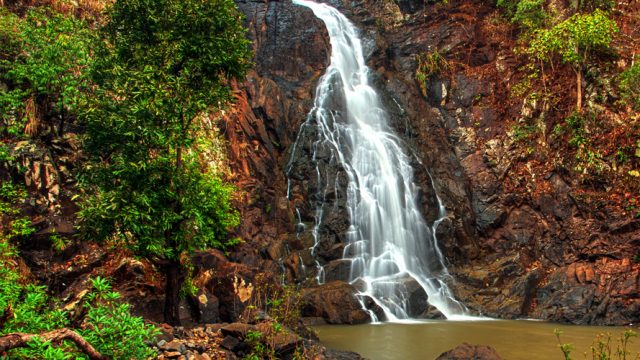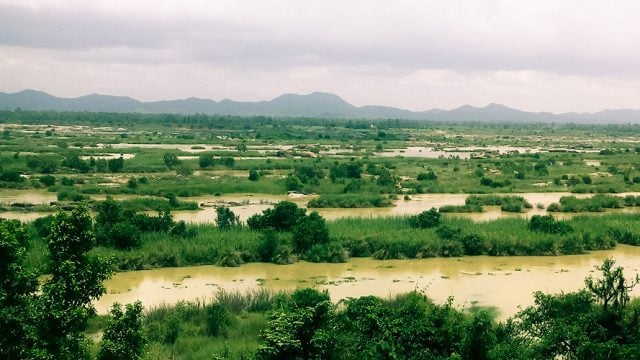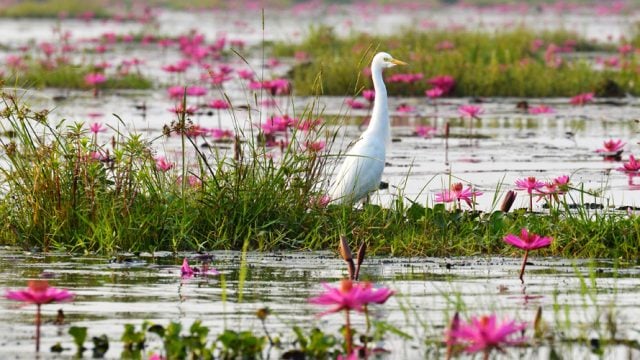It was pitch dark and the narrow mud road was barely discernible in our car’s headlights. Somewhere

Indeed, there was no road marked, but Google Maps insisted that our destination Gajlaxmi Palace was nearby. The seconds ticked away slowly and Kalia sat on the edge of his seat, teeth chattering, his nose to the steering wheel, until we finally saw a white edifice looming to the right. By the time we had finished rejoicing and unloading our bags, our driver had convinced our hosts that we planned to murder him and decamp with his vehicle. Why two travel writers on assignment would want to pop off their driver was perhaps beyond poor Kalia’s comprehension, but we hoped that it was just Dhenkanal’s wilderness and the long drive that distressed him!

This was indeed wild country. Inhabited by aboriginal tribes since prehistoric times and surrounded by lush river valleys and the Bahukhai and Kapilash Forests of the Eastern Ghats, Dhenkanal is home to tigers, elephants and other beasts. Located on the gentle slopes of the Megha Hills, the double-storey palace is tucked in an untamed patch on the town’s quiet outskirts. Jitendra Pratap Singh Deo or JP and his charming wife Navneeta run it as a heritage hotel. Strewn across its living spaces and rooms were large sandooks (chests), period furniture and artefacts, while hunting trophies lined the walls. From a glass showcase in the drawing room, the shiny eyes of the dreaded man-eating tiger of Naranpatna glowered at us. It had claimed 83 victims before being shot by JP’s father Kumar Saheb Ranendra Pratap Singh Deo at Koraput. The trophy and the palace featured in Satyajit Ray’s Royal Bengal Rahasya, shot by Sandip Ray, besides a host of other films.
By morning, Gajlaxmi Palace wore a more cheerful air. We savoured the view of the surrounding forests from the terrace and took a morning walk through the orchard to a water tank frequented by elephants, wild boar, barking deer, civet cats, rabbits, peafowl, jungle fowl and raptors. Being the only water source in the area, it attracted all sorts of wildlife. Our appearance from a thicket startled a sambhar on the opposite bank. Back at the palace, Navneeta explained over breakfast how the palace took seven years to build before being completed in 1942. When she came here from Udaipur in 1998, it was total wilderness and one couldn’t even spot a cyclewala! Her innate Rajasthani love for heritage and hospitality prompted her to convince JP to renovate it into a heritage stay in 2009. They finally opened in February 2011, naming it after the famous Gajlaxmi puja of Dhenkanal.

Despite the proximity to Bhubaneswar airport (100km away), things didn’t look up until they were featured in an international guide as a ‘rural retreat.’ Most of their visitors were from Europe and would often end up extending their stay. JP takes his guests on jeep rides to Satkosia, Saptasajya and other excursions. The summer heat forces the hosts to close down for four months from April, but the rest of the year is excellent for nature walks in the surrounding orchard full of cashew, jackfruit, mango and litchi trees and dense clumps of sal and bamboo. The homegrown produce from the farm like papaya, drumsticks, carrots and cabbage are conveniently used in the kitchen.

Besides Dhenkanal, the extended royal family of Singh Deos also reigned other princely states like Balangir, Kalahandi and Mayurbhanj. Dhenkanal is supposedly named after a Sabara tribal chief called Dhenka who ruled this patch in the 16th century. Sridhar Bhanja, a local chieftain from the neighbouring region of Garh Besalia, vanquished Dhenka in battle. Dhenka’s dying wish was that the area be named after him and his sacred relic be preserved and worshipped. The area was called Dhenkanal in his memory and his relic is worshipped at Dhenkanal Palace to this day!
In 1529, Hari Singh Vidyadhar, commander of the southern forces of Gajapati king Pratap Rudra Deva, defeated the local Bhanja chief and established control over the region. The Gajapati Maharaj crowned him as the Raja of Dhenkanal and, ever since, 18 generations have ruled the throne. Dhenkanal Palace, a large complex on the slopes of the Garhjat Hills, was built at the site of a fort that witnessed a long drawn siege with the Marathas. Six rooms have been reserved for guests, two large family rooms double up as lounges, while the Durbar Hall hosts folk music and dance performances on request. Be it Aul Palace near Bhitarkanika or Parikud Palace near Chilka, many of Odisha’s old palaces are being converted into heritage hotels.

Dhenkanal town doesn’t have major attractions, except the 16th century Siddha Balarama Temple with its 90ft-high spire that towers over town, the Dhenkanal Science Museum near the palace Rajbati and the District Museum, which houses weapons of erstwhile rulers and Paleolithic tools found in archaeological excavations. The presence of Dhenkanal College, Indian Institute of Mass Communication and other educational institutions gives the town a youthful air with a large student population. Snack vendors park their cycles outside schools, colleges and street corners to dish out dahi bada and the eponymous Dhenkanal bada, a traditional fried snack of black gram and rice served with ghughni (yellow pea curry).
After a quick bite at Gourang Mishtan Bhandar, we drove 24km via Karmul to Joranda, the religious headquarters of ‘Mahima Dharma’, a 19th-century monotheistic cult and reform movement that is often described as ‘the world’s youngest religion’. Joranda houses the samadhi of its founder Mahima Gosain. Ascetics in loincloth with long matted hair roamed about the vast complex dotted with temples—Shunya Mandir, Dhuni Mandir and Gadi Mandir. They believe in a single supreme God or parambrahma named Alekha who is formless and omnipresent. Monks lead a life of austerity, celibacy, piety and constant movement, as they cannot sleep in the same place on successive nights or eat twice in the same house. The temples have no idols, only beautiful lamps and feathers and the evening arti is a sublime experience. At the Joranda fair, in existence since 1874, devotees pray together, recite ‘Alekh Brahma’ and burn ghee for universal peace and harmony.
Backtracking to the Y-junction at Kaimati, we continued to Kapilash. At 1,500ft, the lofty peak with its 13th-century Shiva temple of Chandrasekhar is hailed as the ‘Kailash of Odisha’. We parked at the base of the hill, but instead of hiking up 1,351 steps, hired a four-wheel-drive jeep to tackle the steep ghat road and 12 hairpin bends to the temple. The spire of the Shiva temple bears an image of Lord Jagannath, which demonstrates the synthesis of Shaivism and Vaishnavism. East of the main shrine, at a higher altitude of 2,239 ft, stand the temples of Narayan and Vishwanath, the latter being older than the Chandrasekhar temple, hence also called ‘Budha Linga’.
Dhenkanal is excellently placed for excursions. Perched at 900ft, the hill temple of Raghunath or Lord Rama at Saptasajya, 14km away, was built by Rani Ratnaprabha Devi of Dhenkanal. The name Sapta Sajya refers to the ‘seven hills’ where Lord Rama, the Saptarishi (seven celestial sages) and the Pandavas are believed to have stayed. We drove into a nondescript village called Sadeibereni where craftsmen practiced the ancient art of dhokra—an indigenous metal casting technique using the lost wax method where they use clay, beeswax and scrap metal to make bracelets, necklaces and idols of gods and goddesses, besides utilitarian pieces. At the weaving village of Nuapatna, the narrow bylanes resound with the clackety-clack of looms as weavers and master craftsmen avidly share their technique of creating these lovely khandua paat (traditional bandha or ikat saris).

It was again late evening by the time we drove past Chaudwar towards Kila Dalijoda. Kalia was at the wheel and it was pitch dark outside. He cleared his throat nervously and uttered “Babu…,” but luckily we spotted two pillars and on a hunch asked him to drive through. We ended up at a beautiful two-storey stone house and were welcomed by Debjit Prasad Singh Deo and his wife Namrata who run Kila Dalijoda as a heritage homestay. Stone steps led up to a hall of the European style mansion with lovely stained-glass windows, arches and period furniture. Once a hunting lodge of the erstwhile rulers of Panchakote, Kila Dalijoda was built in 1931-33 by Raja Jyoti Prasad Singh Deo. It was named after the adjoining Dalijoda forest range of the Kapilas Elephant Sanctuary that once stretched right up to its doorstep!
The original patch of Kila Dalijoda spread over 11,000 acres; today the holding has shrunk to just 40 acres with two large tanks on the property. While we devoured home-cooked Odiya fare like machha besara (fish in mustard curry), saag (greens) and arisa pitha (deep-fried rice pancake), Debjit helped us plan our trip to Bhitarkanika and nearby craft villages and tiny hamlets of the Saura and Munda tribes. The proximity to the Mahanadi and its back channels gave ample opportunities for fishing and the gently undulating tracts were great for cycling. By the time we were done with Odisha, we had clocked 3,000km. As we bid Kalia goodbye at the Biju Patnaik International Airport at Bhubaneswar, he was teary-eyed but we couldn’t be sure if it was because he was going to miss us, or he was relieved he was still alive…
The information
Getting There
>AIR The nearest airport at Bhubaneswar is 80km from Dhenkanal, and only 45km from Kila Dalijoda. Most airlines fly into Bhubaneswar and the airport is connected to several Indian cities.
>RAIL Dhenkanal Railway Station serves Dhenkanal district and is well connected to Cuttack (55km) on the main Howrah- Chennai route.
>ROAD 75km NW of Bhubaneswar and 55km from Cuttack via NH55 via Chaudwar, while NH42 connects Dhenkanal to Sambalpur and Rourkela.
The Palaces
Many of the royal palaces in and around Dhenkanal have now been converted into heritage hotels and palatial homestays. DHENKANAL PALACE
Tariff: from ₹6,000 per night Contact: +91-9437292448, 9748478335, contact@ dhenkanalpalace.com, dhenkanalpalace.com GAJLAXMI PALACE
Borapada, 3km from Dhenkanal Tariff: from ₹6,500 per night Contact: +91-9861011221, 9337411020, navneeta.singhdeo@ gmail.com, gajlaxmipalace.com
KILA DALIJODA
Ambilijhari, via Chaudwar Tariff: from ₹3,000 per night Contact: +91- 9438667086, [email protected], kiladalijoda.com
What to Eat
Try the Dhenkanal bada and local sweets at Gouranga Sahoo Mistharna Bhandara (+91-6762- 224861, +91-9778228877) on College Road and Prasidha Bara in Ganesh Bazaar. Dhenkanal is also known for its chhunchi patra, a sweet cake made of ground coconut, rice and maida.
When to Go
Dhenkanal is great to visit from October to March. The Joranda fair is held on a full-moon day in the Hindu month of Magha (Jan– Feb). Shivaratri is celebrated at Kapilash with great fervour in Feb- March. The Ramnavami fair at Saptasajya is held in March-April. For more information, contact Tourist Office, TRC Complex, Mahisapat, Dhenkanal 759001; +91-6762-221031, 234670.
royal palaces
Dhenkanal
heritage





